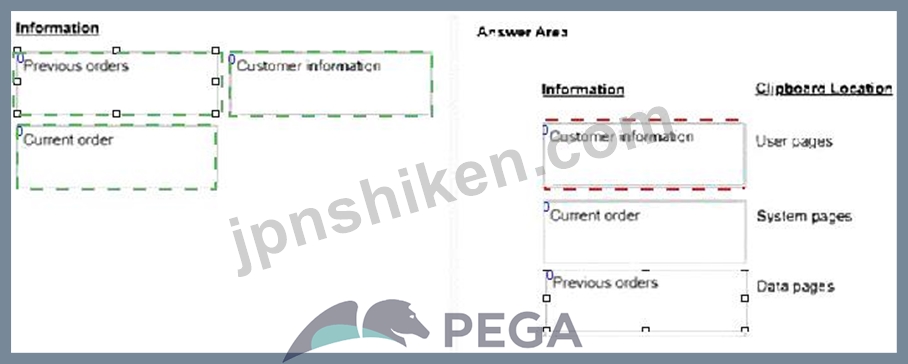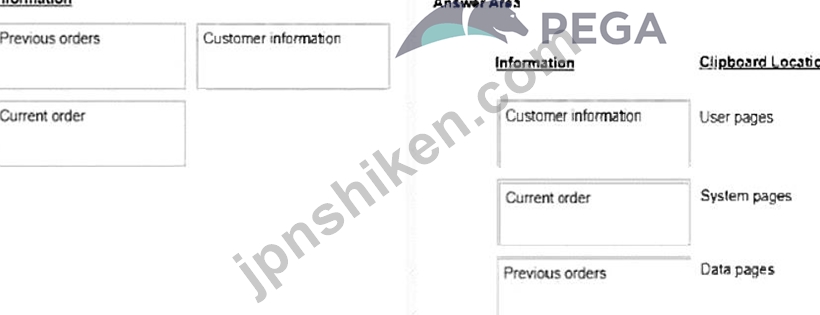- ホーム
- Pegasystems
- PEGACPSA23V1-JPN - Certified Pega System Architect 23 (PEGACPSA23V1日本語版)
- Pegasystems.PEGACPSA23V1-JPN.v2024-09-16.q125
- 質問95
有効的なPEGACPSA23V1-JPN問題集はJPNTest.com提供され、PEGACPSA23V1-JPN試験に合格することに役に立ちます!JPNTest.comは今最新PEGACPSA23V1-JPN試験問題集を提供します。JPNTest.com PEGACPSA23V1-JPN試験問題集はもう更新されました。ここでPEGACPSA23V1-JPN問題集のテストエンジンを手に入れます。
PEGACPSA23V1-JPN問題集最新版のアクセス
「257問、30% ディスカウント、特別な割引コード:JPNshiken」
ドラッグドロップ
組織は、顧客が履行のために注文を行えるケース タイプに対して次の動作を要求します。
アプリケーションは、ログイン時にユーザー ID やロケールなどの顧客情報を識別します。
ケースには、注文ステータスを含め、顧客が行った最後の 10 件の注文がリストされます。
顧客は、現在の注文の基準として、過去 10 件の注文のうち 1 つを選択できます。
左側の各情報を選択し、適切なクリップボードの場所にドラッグします。

組織は、顧客が履行のために注文を行えるケース タイプに対して次の動作を要求します。
アプリケーションは、ログイン時にユーザー ID やロケールなどの顧客情報を識別します。
ケースには、注文ステータスを含め、顧客が行った最後の 10 件の注文がリストされます。
顧客は、現在の注文の基準として、過去 10 件の注文のうち 1 つを選択できます。
左側の各情報を選択し、適切なクリップボードの場所にドラッグします。

正解:

Explanation:

* Customer information: This usually pertains to session-specific data that is relevant to the current user, such as user ID and locale. In Pega, this type of information is typically stored in user pages, which are clipboard pages that contain data related to the current user of the application. User pages are created for each session and include data that pertains to that particular user.
* Previous orders: These are typically a list of orders that are not specific to a session but need to be readily accessible and possibly shared across multiple sessions or users. In Pega, this kind of information is best stored in data pages. Data pages are used to hold data that is loaded once and can be used by multiple users, cases, or processes. They are efficient for data that doesn't change often and is required to be accessed frequently, such as a list of previous orders.
* Current order: This refers to the specific details of the order the customer is currently placing. It is specific to the user's current session and the case they are working on. Therefore, it should be stored in user pages, which are specific to an individual user session and can manage data related to the work they are currently performing.
References:
* Pega's official documentation on Clipboard and Clipboard pages explains how data is categorized and managed within the application.
* Training materials from Pega Academy, which go into detail on the types of clipboard pages and their uses within a Pega application.
- 質問一覧「125問」
- 質問1 次のシナリオを考えてみましょう。 顧客が詐欺行為の苦情を申し
- 質問2 モバイル アプリ チャネルに設定できるオプションはどれですか (...
- 質問3 ユーザー ビューには、ラジオ ボタンで選択できる 4 つの緊急度...
- 質問4 引越し会社は、現在の居住空間の寝室の数と、ベッドフレーム、マ
- 質問5 再生セッション中に、関係者はドロップダウン リストに必要なオ
- 質問6 予約プロセスでは、顧客は旅行の旅程の一部としてフライト、ホテ
- 質問7 ビジネス アーキテクトがケース タイプ用の新しいプロセスを開発...
- 質問8 ケース デザイナーでは、プロジェクトのサイズ設定のために、ユ
- 質問9 親ケース Pl を処理すると、2 つの子ケース Cl と C-2 が作成さ...
- 質問10 マネージャーは、作成日、ケース ID、作成オペレータ、およびワ...
- 質問11 新入社員のハードウェア機器を構成するアプリケーションで、マネ
- 質問12 許可される値のリストが ______________ である場合は、フィール...
- 質問13 旅行の予約を処理するアプリケーションを構成しています。予約ケ
- 質問14 チームがケースを解決しながらより速くコミュニケーションを取り
- 質問15 銀行アプリケーションでは、ユーザーがクレジットカードに残高を
- 質問16 状況に応じてどの要件を実装できますか?
- 質問17 保険金請求アプリケーションには、次の要件があります。すべての
- 質問18 モバイル アプリ チャネルに設定できるオプションはどれですか (...
- 質問19 次の図に示すように、自動車保険会社の 2 つの子ケースを含む事...
- 質問20 自動車事故の請求を処理する場合、システムでは 3 つの承認が必...
- 質問21 国際的なオンライン自動車部品ビジネスでは、顧客があらゆる車両
- 質問22 人事アプリケーションには、採用慣行を確認するために使用される
- 質問23 事務用品を販売するアプリケーションでは、支払いビューに注文品
- 質問24 要件には、顧客がクレジットカードを申請する場合、クレジットカ
- 質問25 音楽スタジオでは、クライアントがオーディオ録音をアップロード
- 質問26 コースのリストを含むフォームを作成しています。ユーザーは登録
- 質問27 顧客が新しい銀行口座を申請するために電話をかけます。カスタマ
- 質問28 ケース デザイナーでは、プロジェクトのサイズ設定のために、ユ
- 質問29 要件は次のとおりです: 1 年生の生年月日は、その年の 9 月 1 日...
- 質問30 従業員の退職パッケージを処理するには、監督管理者の承認が必要
- 質問31 ドラッグドロップ 左側の各ユースケースを選択し、右側の適切な
- 質問32 ページ .Product には、データを使用して外部レコード システム...
- 質問33 顧客は、オンライン ポータルを使用して独自の製品サポート リク...
- 質問34 Open-Review というカスタム ステータスを作成するように求めら...
- 質問35 医療請求ケース タイプを設計しており、次の要件があります: 医...
- 質問36 各マネージャーが作成したケースの数を示す円グラフを作成するよ
- 質問37 ローカリゼーション ウィザードを使用してローカライズするルー
- 質問38 顧客払い戻しケース タイプでは、払い戻し額がアイテムの価格の ...
- 質問39 関係者は、既存のアクションのセットをマルチステップ フォーム
- 質問40 有効なデータを保証する 2 つのデータ要件はどれですか? (2 つ選...
- 質問41 総労働時間、病欠、休暇を示す表が与えられます。それぞれの値を
- 質問42 あなたのオンライン ショッピング アプリケーションは、海外の顧...
- 質問43 ホテル予約アプリケーションでは、予約後に顧客が部屋を変更する
- 質問44 トレーサー ツールを使用して追跡できるイベントは次のどれです
- 質問45 従業員、雇用日、およびマネージャーのリストを含む新しいレポー
- 質問46 委任を通じてどのようなビジネスニーズに対処しますか?
- 質問47 住宅ローンの申請には、法務チーム マネージャーと財務チーム マ...
- 質問48 データ オブジェクトに関する次の 2 つの記述のうち正しいものは...
- 質問49 Pega Express で新しい子ケースにデータを伝播するにはどうすれ...
- 質問50 ユーザー インターフェイス (Ul) アクション セットの最小コンポ...
- 質問51 2 つの別々のユニットのオペレーターが、いずれかのユニットにル...
- 質問52 顧客が複数のオファーを選択できないように、単一のコントロール
- 質問53 ユーザーは、画面サイズの異なるさまざまなデバイスからアパート
- 質問54 次のシナリオを検討してください。求人応募ケースの面接プロセス
- 質問55 Direct Capture of Objectives (DCO) は、アプリケーション配信...
- 質問56 要件には、ローン申請者は年収を入力する必要がある、と記載され
- 質問57 ユーザーは、プロジェクトのサイズ設定のために、ケース デザイ
- 質問58 奨学金申請を処理するケース タイプを開発しています。奨学金申
- 質問59 ユーザーは保険金支払いを承認するために保険適用リクエスト ケ
- 質問60 部門内の空いているメンバーなら誰でもタスクを実行できるように
- 質問61 次の例は、ログインしたオペレータのルールセット リストを示し
- 質問62 テキスト、複数レコードデータの関係、単一レコードデータの関係
- 質問63 即時ローンの資格を得るには、申請者は少なくとも月収 2,000 ポ...
- 質問64 レストランには、顧客がイベント用にダイニング ルームを予約で
- 質問65 顧客が以前の注文の内容を現在の注文にコピーしたいと考えていま
- 質問66 データ レコードに関する次の 2 つの記述のうち正しいものはどれ...
- 質問67 チャネル インターフェイスに関する次の記述のうち正しいものは
- 質問68 アパートの入居者は、名前、住所、リクエストの種類、リクエスト
- 質問69 チェックボックスが選択されている場合にのみ、携帯電話番号を入
- 質問70 UI がまだ構成されていない航空券予約ケース タイプをテストして...
- 質問71 開発者は、計算されたプロパティ値が予期しない結果を返している
- 質問72 購入リクエストの金額に応じて、承認はユーザーから融資担当者、
- 質問73 事故のクレームケースでは、事故に巻き込まれた各車両に対して車
- 質問74 要件は次のとおりです: 顧客は、次の手順を実行することで、ケー...
- 質問75 フロー アクションは、値を初期化するために前処理データ変換を
- 質問76 従業員は休暇申請を提出しますが、これは上司の承認が必要です。
- 質問77 レポートには、顧客、請求サイクル、クレジットカード、有効期限
- 質問78 次の返金ケースのライフサイクルを使用して、アイテムが返品され
- 質問79 リスト レポートには、購入リクエストと地域コスト センターの列...
- 質問80 プロセス レポートはどの 2 つのオプションですか? (2 つ選択し...
- 質問81 自動車保険請求のビジネス プロセスは、次のフェーズで構成され
- 質問82 対応を構成する必要があることを示す 2 つの要件はどれですか? (...
- 質問83 自動車保険の見積もりには、潜在的な顧客がリクエストを処理する
- 質問84 顧客はカラー オプションを利用できますが、オプションは画面上
- 質問85 大企業の求人応募を処理するためのケース タイプを作成していま
- 質問86 ビューでのスクロールを減らすには、ドロップダウン メニューで
- 質問87 要件には、「納税者番号は 10 桁でなければなりません」と記載さ...
- 質問88 スタッフが使用する図書館アプリケーションは、会員が 1 冊以上...
- 質問89 ホテル予約アプリケーションの顧客は、予約に追加のアメニティを
- 質問90 営業マネージャーは、電子メールとモバイル デバイスから営業見
- 質問91 次の要件を考慮してください。 患者は、主要なケース処理に影響
- 質問92 目標間隔が経過したときに割り当ての緊急度を 100 に調整するよ...
- 質問93 病院のスタッフは、関連する患者情報、診断、検査指示、処方薬な
- 質問94 割り当てがユーザーのワークリストに追加されたときにユーザーに
- 質問95 ドラッグドロップ 組織は、顧客が履行のために注文を行えるケー
- 質問96 注文履行ケース タイプでは、顧客が注文処理段階でユーザー プロ...
- 質問97 顧客のさまざまなアカウントを表示し、銀行取引を行えるケース
- 質問98 ある組織には、子供向けの書籍の販売と大学の教科書の再販という
- 質問99 アカウント情報の収集割り当てステップで、新規潜在顧客の最低年
- 質問100 注文合計額が USD10000 を超える顧客注文ケースを、作成日 (pxCr...
- 質問101 Pega の動的 UL 動作を示すユースケースを 3 つ選択してください...
- 質問102 顧客は、氏名と会員 ID 番号を入力して、会社のロイヤルティ プ...
- 質問103 画像の代替テキストが欠落しているかどうかを確認するために使用
- 質問104 データ要素を構成する 2 つの情報は何ですか? (2 つ選択)...
- 質問105 最も適切な重大度オプションを1つ選択する必要があります
- 質問106 信用限度額の増額を申請する場合、標準クレジットカードのお客様
- 質問107 採用応募の場合: * 従業員が候補者と面接します。 * 人事 (HR) ...
- 質問108 App Studio のコントロールのスタイル設定に関して正しい記述は...
- 質問109 建設アプリケーションでは、次の図に示すように、ユーザー アク
- 質問110 社内アプリケーションでは、75 人の従業員に、管理者、作成者、...
- 質問111 出張承認には、申請者のマネージャー、部門 VP、および合計金額...
- 質問112 フォームはアクセシビリティをサポートする必要があります。ユー
- 質問113 ケースで有効なデータが使用されることを保証する 2 つの要件は...
- 質問114 データ変換を使用することで満たされる 2 つの要件を特定します...
- 質問115 サービス レベル アグリーメントを構成することで満たされる要件...
- 質問116 複数の開発チームがさまざまな機能強化に取り組んでいます。 各
- 質問117 信用限度額の増額を申請する場合、標準クレジットカードのお客様
- 質問118 即時ローンの資格を得るには、申請者は少なくとも月収が 2,000 ...
- 質問119 アプリケーションでは、コンサルタントがプロジェクトで働いた時
- 質問120 オンライン小売アプリケーションでは、注文受領ビューに、製品画
- 質問121 Constellation アーキテクチャ上に構築されたアプリケーションで...
- 質問122 あるオンライン小売業者は、顧客が配送に宅配便を選択できるよう
- 質問123 ケース設計の一環として、誰かが購入を完了すると、アプリケーシ
- 質問124 データ ページには製品情報が保存されています。データ ページの...
- 質問125 期限切れ間隔を 3 回繰り返すサービス レベル アグリーメント (S...

[×]
Download PDF File
Enter your email address to download Pegasystems.PEGACPSA23V1-JPN.v2024-09-16.q125.pdf
